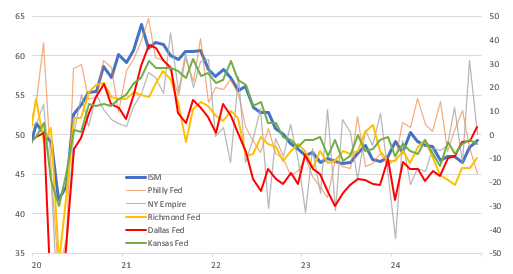U.S. Manufacturing Shows Encouraging Signs Of Life
After languishing for much of the past two years, both the production and new orders components of the ISM manufacturing report have moved into growth territory. However, caution remains with the employment component suggesting jobs continue to be shed while tariff uncertainty remains a concern, particularly for those with international supply chains and those where exports are an important source of revenue.

Image Source: Pexels
Production returns to growth, but employment is weakening
The December US ISM manufacturing index has come in stronger than predicted, rising to 49.3 from 48.4 in November versus the 48.2 consensus. Regional indicators had been mixed, but we don't have any regional metrics for west of the Rocky Mountains, so it seems that activity on the West Coast has outperformed the rest of the country.
The improvement was led by a rise in the production component to 50.3 from 46.8 which may have been boosted by the return to work of formerly striking Boeing workers. This was the first reading above 50 since May – remember 50 is the break-even level consistent with flat activity so anything above is expansion and below 50 is contraction. New orders came in above 50 for a second consecutive month (52.5 after 50.4 in November). Nonetheless, the backlog of orders continues to contract while the employment component softened to 45.3 from 48.1 so there appears to be some caution about whether this truly is a turnaround for a sector that has languished over the past couple of years.
ISM manufacturing outperformed regional indicators

Source: Macrobond, ING
Tariff uncertainty makes planning tough
While President-elect Donald Trump has promised lower corporation taxes, tariff uncertainty will remain a concern and right now, manufacturers have little visibility on the timing and scale of potential action. While notionally it should make US-made products more competitive on the domestic stage due to higher prices charged for foreign-made products, it will be disruptive for those that use an international supply chain, and manufacturing exporters will be wary about foreign reprisals. As a result, US manufacturing activity looks set to remain subdued at least until there is some clarity on the trading environment they face.
More By This Author:
Poland’s Inflation Growth Below Market Expectations As Rise In Food Prices SlowsBenign Food Prices Help Turkey’s Disinflation Path
FX Daily: More Of The Same To Start The Year
Disclaimer: This publication has been prepared by the Economic and Financial Analysis Division of ING Bank N.V. (“ING”) solely for information purposes without regard to any ...
more


